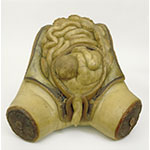In the advanced stage of labor depicted in this obstetrical wax model, the fetus, has its back in anterior position and presents the left shoulder. The uterine muscle is pressing heavily against the fetus and is shown retracted toward the back and overextended in the inferior segment. The spinal column is folded and curved on its cervical side. The left shoulder is wedged in the pelvic cavity, and the corresponding limb has moved away from the trunk and is visible in the vulva. Without medical intervention, this situation inevitably caused the mother's death owing to the rupture of the uterus. The fetus died as well, owing to the compression of the visceral organs and the umbilical cord. Until the eighteenth century, it was believed that the exit of the arm precluded expulsion or rotation, and hence that the limb had to be reduced or extracted in order to deliver the fetus. In the nineteenth century, practice showed that the obstetrician's hand could fit into the vagina even with the arm present; consequently, the fetus could be rotated.
The model was commissioned by Felice Fontana, who was working on the installation of the Museo di Fisica e Storia Naturale of Florence, from the sculptor Giuseppe Ferrini and his assistant Clemente Susini.










